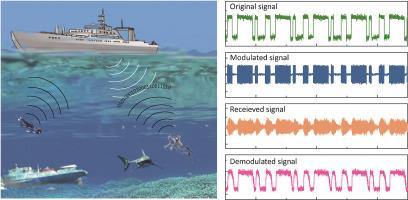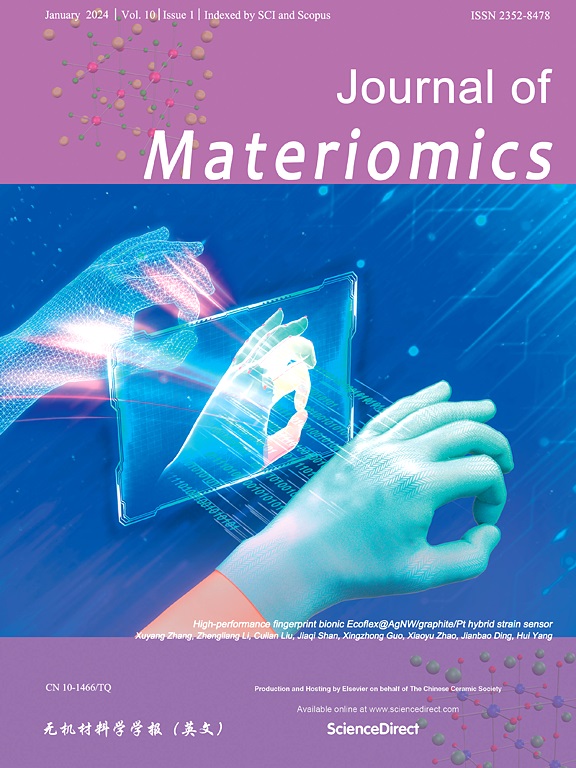通过压电和机电协同优化策略制作极低频磁电天线
IF 8.4
1区 材料科学
Q1 CHEMISTRY, PHYSICAL
引用次数: 0
摘要
海洋地质和海洋资源勘探的蓬勃发展导致了对无线电导航或特殊环境通信的巨大需求,进而推动了便携式水下无线通信技术的快速发展。目前使用的最先进的声学通信方法存在严重的传输延迟、多径效应和多普勒频移等问题,从而阻碍了水下无线通信技术的发展。低频电磁传输已被证明是一种前景广阔的水下通信解决方案,但传统的电子天线对于便携式水下无线通信来说过于庞大。由压电材料驱动的新兴磁电(ME)天线已成为极低频(VLF)通信系统小型化的一种有前途的解决方案。在此,我们对 ME 天线的辐射性能与压电材料特性之间的关系进行了理论建模。在理论分析的指导下,设计了同时具有高 d33 和 Qm(d33 ∼ 401,Qm ∼ 1510)的 Pb(In1/2Nb1/2)O3Pb(Mn1/3Sb2/3)O3Pb(Zr0.49Ti0.51)O3(PIN-PMS-PZT)压电陶瓷,以增强甚低频 ME 天线的磁电辐射。基于 PIN-PMS-PZT 的 ME 天线在 EMR 方面实现了 1.78 Gs⋅cm/V 的大反向磁电响应,几乎是基于 PZT 的商用 ME 天线的两倍。更重要的是,基于该 VLF 天线建立了一个 VLF 通信系统,该系统成功地利用移幅键控(ASK)调制传输了数字信号。相信这项研究成果能为未来 ME 天线的应用提供理论基础和可行的技术途径。本文章由计算机程序翻译,如有差异,请以英文原文为准。

Crafting very low frequency magnetoelectric antenna via piezoelectric and electromechanical synergic optimization strategy
A boom in exploration for marine geology and ocean resources has resulted in a huge demand for radio navigation or special environment communications, in turn spurring the rapid development of portable underwater wireless communication technology. State of the art acoustic communication methods used today are plagued by substantial transmission delays, multipath effects, and doppler frequency shifts, among other challenges, thus impeding the advancement of underwater wireless communication technology. Low-frequency electromagnetic transmission has proven to be a prospective solution for underwater communication, but the conventional electrical antennas is too large for portable underwater wireless communication. Emergent magnetoelectric (ME) antennas driven by piezoelectric materials have become a promising solution for miniaturizing very low frequency (VLF) communication systems. Here, a theoretical model between the radiation performance and piezoelectric material properties of the ME antenna was conducted. Guide by the theory analysis, Pb(In1/2Nb1/2)O3![]() Pb(Mn1/3Sb2/3)O3
Pb(Mn1/3Sb2/3)O3![]() Pb(Zr0.49Ti0.51)O3 (PIN-PMS-PZT) piezoelectric ceramic simultaneous with high d33 and Qm (d33 ∼ 401, Qm ∼ 1510) has been designed to enhance the magnetoelectric radiation of the VLF ME antenna. The PIN-PMS-PZT based ME antenna achieves a large converse magnetoelectric response 1.78 Gs⋅cm/V in EMR, which is almost doubled to commercial PZT based ME antenna. More importantly, a VLF communication system was built based on the VLF antenna, which successfully transmitted digital signals using Amplitude-Shift-Keying (ASK) modulation. It is believed that the presented work could provide a theoretical basis and feasible technical path for the employment of ME antennas in the future.
Pb(Zr0.49Ti0.51)O3 (PIN-PMS-PZT) piezoelectric ceramic simultaneous with high d33 and Qm (d33 ∼ 401, Qm ∼ 1510) has been designed to enhance the magnetoelectric radiation of the VLF ME antenna. The PIN-PMS-PZT based ME antenna achieves a large converse magnetoelectric response 1.78 Gs⋅cm/V in EMR, which is almost doubled to commercial PZT based ME antenna. More importantly, a VLF communication system was built based on the VLF antenna, which successfully transmitted digital signals using Amplitude-Shift-Keying (ASK) modulation. It is believed that the presented work could provide a theoretical basis and feasible technical path for the employment of ME antennas in the future.
求助全文
通过发布文献求助,成功后即可免费获取论文全文。
去求助
来源期刊

Journal of Materiomics
Materials Science-Metals and Alloys
CiteScore
14.30
自引率
6.40%
发文量
331
审稿时长
37 days
期刊介绍:
The Journal of Materiomics is a peer-reviewed open-access journal that aims to serve as a forum for the continuous dissemination of research within the field of materials science. It particularly emphasizes systematic studies on the relationships between composition, processing, structure, property, and performance of advanced materials. The journal is supported by the Chinese Ceramic Society and is indexed in SCIE and Scopus. It is commonly referred to as J Materiomics.
 求助内容:
求助内容: 应助结果提醒方式:
应助结果提醒方式:


